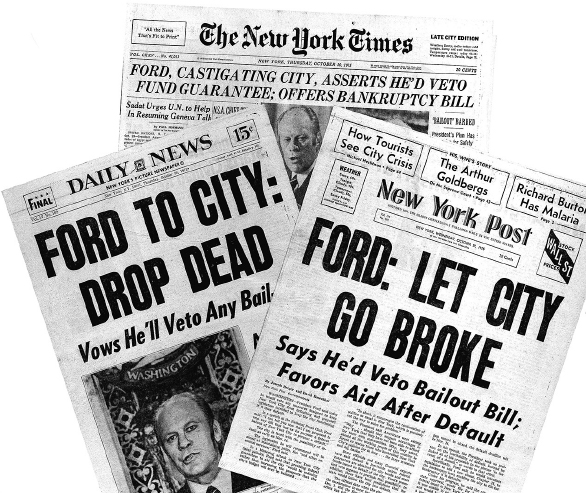America’s History: Printed Page 945
America: A Concise History: Printed Page 856
America’s History: Value Edition: Printed Page 835
Urban Crisis and Suburban Revolt
The economic downturn pushed already struggling American cities to the brink of fiscal collapse. Middle-class flight to the suburbs continued apace, and the “urban crisis” of the 1960s spilled into the “era of limits.” Facing huge price inflation and mounting piles of debt — to finance social services for the poor and to replace disappearing tax revenue — nearly every major American city struggled to pay its bills in the 1970s. Surrounded by prosperous postwar suburbs, central cities seemingly could not catch a break.
New York, the nation’s financial capital and its largest city, fared the worst. Its annual budget was in the billions, larger than that of most states. Unable to borrow on the tightening international bond market, New York neared collapse in the summer of 1975; bankruptcy was a real possibility. When Mayor Abraham Beame appealed to the federal government for assistance, President Ford refused. “Ford to City: Drop Dead” read the headline in the New York Daily News. Fresh appeals ultimately produced a solution: the federal government would lend New York money, and banks would declare a three-year moratorium on municipal debt. The arrangement saved the city from defaulting, but the mayor was forced to cut city services, freeze wages, and lay off workers. One pessimistic observer declared that “the banks have been saved, and the city has been condemned.”

Cities faced declining fortunes in these years for many reasons, but one key was the continued loss of residents and businesses to nearby suburbs. In the 1970s alone, 13 million people (6 percent of the total U.S. population) moved to the suburbs. New suburban shopping centers opened weekly across the country, and other businesses — such as banks, insurance companies, and technology firms — increasingly sought suburban locations. More and more, people lived and worked in suburbs. In the San Francisco Bay area, 75 percent of all daily commutes were suburb-to-suburb, and 78 percent of New York’s suburban residents worked in nearby suburbs. The 1950s “organization man,” commuting downtown from his suburban home, had been replaced by the engineer, teacher, nurse, student, and carpenter who lived in one suburb and worked in another.
Beyond city limits, suburbanization and the economic crisis combined powerfully in what became known as the tax revolt, a dramatic reversal of the postwar spirit of generous public investment. The premier example was California. Inflation pushed real estate values upward, and property taxes skyrocketed. Hardest hit were suburban property owners, along with retirees and others on fixed incomes, who suddenly faced unaffordable tax bills. Into this dire situation stepped Howard Jarvis, a conservative anti–New Dealer and a genius at mobilizing grassroots discontent. In 1978, Jarvis proposed Proposition 13, an initiative that would roll back property taxes, cap future increases for present owners, and require that all tax measures have a two-thirds majority in the legislature. Despite opposition by virtually the entire state leadership, including politicians from both parties, Californians voted overwhelmingly for Jarvis’s measure.
Proposition 13 hobbled public spending in the nation’s most populous state. Per capita funding of California public schools, once the envy of the nation, plunged from the top tier to the bottom, where it was second only to Mississippi. Moreover, Proposition 13’s complicated formula benefitted middle-class and wealthy home owners at the expense of less-well-off citizens, especially those who depended heavily on public services. Businesses, too, came out ahead, because commercial property got the same protection as residential property. More broadly, Proposition 13 inspired tax revolts across the country and helped conservatives define an enduring issue: low taxes.
In addition to public investment, another cardinal marker of New Deal and Great Society liberalism had been a remarkable decline in income inequality. In the 1970s, that trend reversed, and the wealthiest Americans, those among the top 10 percent, began to pull ahead again. As corporations restructured to boost profits during the 1970s slump, they increasingly laid off high-wage workers, paid the remaining workers less, and relocated overseas. Thus upper-class Americans benefitted, while blue-collar families who had been lifted into the middle class during the postwar boom increasingly lost out. An unmistakable trend was apparent by the end of the 1970s. The U.S. labor market was dividing in two: a vast, low-wage market at the bottom and a much narrower high-wage market at the top, with the middle squeezed smaller and smaller.
COMPARE AND CONTRAST
Question
How did cities and suburbs experience the “era of limits” differently, and why?